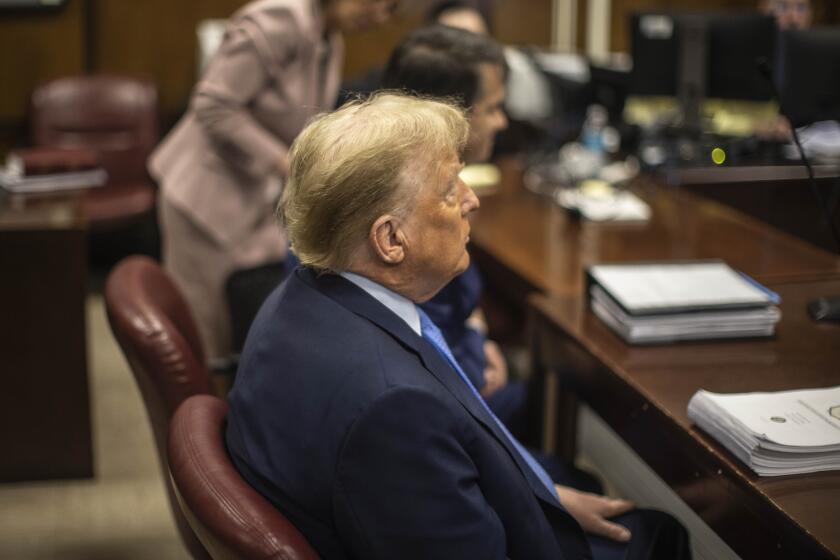Removing Nuclear Material From Livermore Examined
The Energy Department will examine moving plutonium and highly enriched uranium out of California’s Lawrence Livermore National Laboratory to help improve security against a terrorist attack, Secretary Spencer Abraham said Friday.
The announcement probably will set off a high-stakes political battle over the future of Livermore, one of the nation’s two nuclear weapons design labs and a cornerstone of the Bay Area’s technology sector.
By early next year, Abraham said, the department will determine whether the stockpiles of bomb-grade material now stored at the lab should be moved to a more secure location. Although Livermore needs the bomb materials to support the nation’s nuclear weapons program, the secretary said, the department “should look for a better solution.”
The review is part of a sweeping safety overhaul at the department’s sprawling nuclear weapons sites, which have been hit by a rash of security breakdowns in recent years.
Although existing security is excellent, Abraham said, it must be improved in response to post-Sept. 11 realities; he outlined a detailed agenda for shoring up both the nuclear complexes and the quality of the forces guarding them.
The plan calls for nuclear materials to be removed or consolidated at Los Alamos National Laboratory in New Mexico, Sandia National Laboratory in New Mexico and the Savannah River Site in South Carolina. A high-security facility would be constructed at the Oakridge National Laboratory in Tennessee to store highly enriched uranium.
The department also will examine whether to blend down, or dilute, more than a ton of excessive uranium so that it could no longer be used for bombs.
Abraham on Friday raised the possibility of federalizing the security forces that protect bomb-grade materials, a move that the guard unions long have advocated as a way to increase professionalism and create more consistent standards at different sites.
The Energy Department also would eliminate all disk drives from desktop computers used to conduct classified nuclear weapons research, thereby making the theft of information more difficult. The loss or theft of disks was at the center of several high-profile investigations over the last decade.
Among the safety measures outlined Friday, all physical keys to locks at gates and buildings would be replaced by electronic or biometric ones.
“We are all too familiar with reports of poor performance ... of sleeping on duty and of repeatedly losing keys,” Abraham said, referring to several high-profile security gaffes. “They are unacceptable ... and will not be tolerated.”
The improvement plan Abraham outlined reflected recommendations made by outside agencies and critics, including a number of former Energy Department managers, the General Accounting Office and the Project on Government Oversight, a Washington public interest group that has pushed for better weapon-site security.
Peter Stockton, an investigator for the oversight group and a former Energy security advisor, said Friday that Abraham’s priorities were well-placed. Union officials also applauded the possibility that contract guards could be part of an elite, federalized security force.
But other experts who support the goal of improving security are troubled by the possibility of moving plutonium and highly enriched uranium from Livermore.
Phil Coyle, former deputy director at Livermore and a former high-ranking Pentagon official, said removing bomb-grade material from the research facility would make it more difficult to justify continued research there. Since the end of the Cold War, Livermore successfully has rebuffed critics who said that the nation does not need two labs supporting the nuclear weapons program and that Los Alamos could handle all the work.
“I am a strong believer in having two design labs,” Coyle said. “Nuclear weapons are special, and you don’t want one organization having a monopoly on the research.... Abraham will have to take this into account.”
“If they have to reduce materials at Livermore to the point where they can’t do their work, then people will ask why everything just can’t be done at Los Alamos,” he added.
At the same time, Abraham is considering whether to end the University of California’s contract to operate Los Alamos, after a series of financial and security scandals at the lab. The possibility of having a new contractor at Los Alamos could further complicate the future of Livermore.
Such risks were evident Friday to the political supporters of Livermore. Rep. Ellen O. Tauscher (D-Alamo), whose district includes Livermore, said that although “there is excess nuclear material” at the lab, “some special nuclear material must remain ... if it is to perform its essential national security mission.”
The plan set out by Abraham follows reports and investigations that have found serious weaknesses in the Energy Department’s security over the last several years. As recently as last week, the General Accounting Office said the department was underestimating the potential terrorist threat it faces and had moved too slowly to shore up its defenses.
At least half a dozen Energy officials and security supervisors have been fired after raising similar concerns; many were reinstated by court order.
Abraham acknowledged Friday that the department had resisted outside opinions and now needed a change in culture.
“I am concerned that too many employees believe that their only recourse to address system failures is to go the media or the inspector general,” Abraham said. “People should not be afraid to bring problems to the attention of management or worried about facing retribution.”
More to Read
Get the L.A. Times Politics newsletter
Deeply reported insights into legislation, politics and policy from Sacramento, Washington and beyond. In your inbox three times per week.
You may occasionally receive promotional content from the Los Angeles Times.







